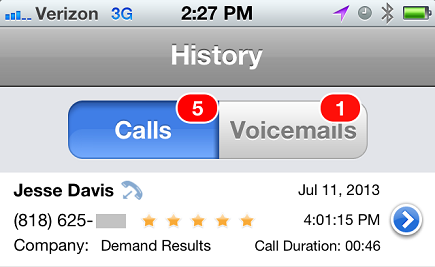5 Secrets to Leaving the Perfect Sales Voicemail
Imagine that you’re an inside sales rep at a B2B company. You’ve exchanged a couple of emails with a key decision maker, and she invited you to give her a call. You’re pumped up with adrenaline, ready to convince her that buying your company’s software solution will be the best investment she’ll ever make. After five rings, she finally picks up and says hello. It’s go time! But wait – it’s just a recording. You’ve reached her voicemail.
 Many sales reps spend hours each day calling prospects. Many of those calls go to voicemail. So what are you going to do? Panic? Try again later? Key decision makers are busy. Much of the time they let their calls go to voicemail so they can call you back when they have a free minute. That means that perfecting the art of the voicemail is a necessary component of inside sales.
Many sales reps spend hours each day calling prospects. Many of those calls go to voicemail. So what are you going to do? Panic? Try again later? Key decision makers are busy. Much of the time they let their calls go to voicemail so they can call you back when they have a free minute. That means that perfecting the art of the voicemail is a necessary component of inside sales.
The fact is that for many inside sales reps, there is no art to the voicemail at all. They simply leave their name, business and phone number and ask for a call back. Or worse yet, they go rambling on like someone’s drunk uncle at a wedding. But the most successful sales reps always have a plan. Here are some tips to help you leave the best sales voicemails ever.
1. Choose the Right Tone
It’s important to get your tone and vocal cadence right. Sure, some things are universal, you always want to sound confident and friendly. But beyond that, there are several nuances to choosing the right tone. For example, are you following up with a new prospect or returning customer? If they’ve bought from your company before, you can assume a more casual and familiar tone, even if you’ve never personally spoken with the lead.
 LinkedIn can often provide a wealth of information about prospects, including their picture. One social sales technique that I use when talking to a lead for the first time is to scope out their picture and pretend that I’m sitting at an in-person office with them. While you never truly know what someone’s personality will be like until speaking with them, in general, I’ll use a slightly different tone with a mid-20s man than I would with a woman in her mid 50s. Getting the exact job title helps too. I might address a CEO a bit more formally than an IT manager. Time permitting, I also try to check out a lead’s Twitter feed to try to get a sense of their personality before calling. Our inside sales apps can help reps take a quick look at prospects’ LinkedIn, Twitter and Facebook feeds before outbound calls.
LinkedIn can often provide a wealth of information about prospects, including their picture. One social sales technique that I use when talking to a lead for the first time is to scope out their picture and pretend that I’m sitting at an in-person office with them. While you never truly know what someone’s personality will be like until speaking with them, in general, I’ll use a slightly different tone with a mid-20s man than I would with a woman in her mid 50s. Getting the exact job title helps too. I might address a CEO a bit more formally than an IT manager. Time permitting, I also try to check out a lead’s Twitter feed to try to get a sense of their personality before calling. Our inside sales apps can help reps take a quick look at prospects’ LinkedIn, Twitter and Facebook feeds before outbound calls.
2. Craft a Narrative
I look at each voicemail as a moment in a linear story. I start with the past, mentioning an email correspondence (even if they never responded to your email, you can still refer to a past email as a point of reference.) I then skip to the present and emphasize the reason why I’m calling. Finally, I mention a future conversation. And by the way, I act on the assumption that that future conversation is going to definitely take place. “I’m looking forward to talking with you soon about how our call tracking solution can make your advertising budget more effective.”
3. Convey Urgency
You want leads to call you back as soon as possible, but you don’t want to apply back-breaking pressure. I like to convey what I call “relaxed urgency” in order to try to get a lead to call back. One way I do this is by using a time constraint. “I have a meeting with a client in a couple hours, and I’m hoping that we can chat beforehand.” Don’t worry, if they don’t call you back before your “meeting” – you can always try them again. The importance of persistence in inside sales is well-established.
4. Mention a Mutual Connection
Peer-based selling (i.e. involving a lead’s peer group in the sales process) is a powerful technique for instantly establishing credibility. If you have done business previously with one of a lead’s LinkedIn connections or co-workers it can often be a good idea to mention this mutual connection. If you don’t have a mutual connection worth mentioning, fear not. If you do business with a company that is a known name in your industry, feel free to drop that name in your voicemail as a point of reference.
5. Leave Nothing to Chance – Write Voicemail Scripts
The scouts have a motto: be prepared. In sales, being prepared means that before you pick up the phone to make an outbound call, you know every single word you’re going to say if the call goes to voicemail. This involves creating some voicemail script templates for various roles or situations. You can keep your scripts general, or get more granular depending on your business model.
For example, we have a sales script geared at decision-level sales managers who have downloaded one of our whitepapers. If you know what you’re going to say and you’ve selected the right tone, there will be no guesswork or anxiety involved in leaving voicemails.
By adequately preparing for voicemails, you’re likely to notice some real results. But if you want to know for certain, CRM tools can help Sales track which messages are resonating. Revenue.io can connect business telephony to Salesforce.com, enabling sales managers to keep better tabs on which voicemail scripts are generating the best returns.
